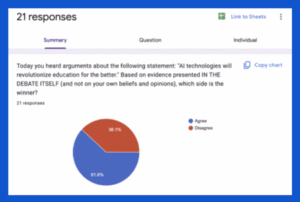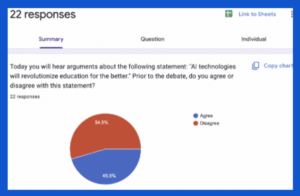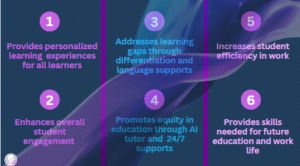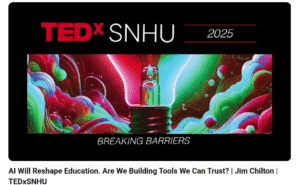This reflection feels different than the others I’ve done, because this was ‘’my debate.’ Sheila and I took on Daegan and Jessalyn in scenario #3: AI technologies will revolutionize education for the better, the most divided topic yet shown in the pre-vote (with some change in the post-vote – whoop whoop!):
(Pre-vote & post-vote visuals)


Sheila and I tackled the ‘pro’ side spending A LOT of time reading, listening and watching content to help our case that AI = good for education…which was tougher than I anticipated, especially because I have many reservations about AI myself (I know, shocking as I spent nearly an hour trying to argue the pro-side haha). I was expecting the vote to lean in our favour. I thought – ‘technology class…yeah people will be pro-AI…our side will be the favourite’ and was surprised when that wasn’t the case initially.
Perhaps I shouldn’t have been shocked by this, as AI is such a new beast in the world of technology and the implications on education are JUST starting to emerge. As well, while listening to my peer’s experience with AI in their classrooms (student-use specifically), I think I was a tad naive to the issues AI is already causing with academic misconduct. Teaching primary, I haven’t dealt with this concern (yet).
AI for the better
AI technologies WILL revolutionize education for the better.
Even amidst my reservations, I still agree with this statement…although I might tack on ‘in 15 years’ to that statement. It’s clear that years and years of AI related growing pains await. Learning, problem solving, crisis management, learning some more, AI is going to be challenging to figure out; both for how educators can best utilise it ethically and how students can access in ways that support (not replace) their learning.
I do strongly believe in the benefits AI provides (or can provide) teachers and students, as Sheila and I presented in our opening statement. We focused on two main categories: benefits to students and benefits to teachers, and what a labour of love it was trying to fit all of our research and ideas into a concise 5-minute video!
From the open debate conversation, I gathered that many of us have dabbled in AI use to help with our own planning, differentiation efforts, creating learning activities, and could acknowledge the ease of use and time savings AI tech provides us. Time savings is my FAVOURITE benefit to teachers, because, let’s be real, there is NOT enough time in our days to do everything (well). Having AI as a free, at our fingertips tool, to quickly think up a writing prompt, translate a worksheet (French Immersion perk), simplify a passage, or create an open-ended Math question is invaluable. This alone made me ‘buy in’ quickly to AI use for educators.
 The benefits to students are undeniable as well.
The benefits to students are undeniable as well.
This article was my starting point in seeing the benefits to students, further supported with many, many others. Here are a few other key readings we came across on AI’s benefits:
- https://www.weforum.org/stories/2024/04/future-learning-ai-revolutionizing-education-4-0/
- https://www.industryandbusiness.ca/how-canadian-schools-are-transforming-education-with-ai-programs-that-work/?utm_source=chatgpt.com
- https://provost.wsu.edu/benefits-of-ai/
While our research highly supports AI usage for student learning, allowing AI tech usage in our classrooms feels daunting and there is lots to consider when introducing this tech to students (kids), as with any new technology. Similar to my second blog post on technology use in the class, in general, I would use the same ‘cautiously optimistic’ approach here with AI.
AI for the worse
AI technologies will NOT revolutionize education for the better.
Daegan and Jessalyn argued the ‘against’ side of our debate, introducing numerous concerns in their (extremely creative) opening statement video. They were tough competition, delving into AI issues of privacy, bias, misinformation, lack of human interaction, social divide, teacher burnout and, most prominently, academic misconduct. All valid concerns that we all worry about as AI is starting to take over the world of technology in and outside of the classroom.
They provided thought-provoking resources that could have even AI’s biggest supporters struggling to defend. Their first article discusses the misuse of AI, harming learners and teachers alike, with the heading “Smart tools and lazy minds” standing out. As well, they share an alarming YouTube video displaying the easy spread of misinformation: https://www.youtube.com/watch?v=ojjn9T_fuUw. Misinformation has been a long time growing issue online, especially on social media, impacting all users – from kids to adults alike. AI makes misinformation even easier to spread and harder to distinguish between, especially problematic for kids that are still developing digital literacy and critical thinking skills. There is no easy answer to address this, aside from education, education, education (easier said than done, I realize).
Their fourth article focuses on the issue of over-reliance on AI, a growing concern, especially in young users. This will be a tough issue to combat, as AI makes it easy to simply garner seemingly perfect results and doesn’t require critical thinking on the part of the user. That being said, I think about Dustin’s interjection during the debate, suggesting AI can actually promote critical thinking, challenging users to think more critically than ever before. Of course, like all skills, this will be something educators need to explicitly teach and practice with their students.
AI for better OR for worse
For better or for worse, AI technology is here. It’s embedded into almost every program we use, it’s free, it’s accessible to all (students included), it’s easy to use, and it’s already changing education…ready or not. So many questions continue to flood my mind:
- How do we monitor AI use? What’s manageable for teachers?
- How do we educate students on this technology, when we are still learning ourselves and when it’s constantly evolving?
- How do we prevent cheating or misuse of this tech? How do we ensure students are still thinking for themselves?
- How do we ensure safety and prevent misinformation when kids are using AI?
- How do we protect student privacy?
These aren’t easily answerable questions, but they are issues that we will need to deal with regardless of our stance on AI. Embracing AI with an open mindset may be the best way for us to stay sane and help our students navigate this tech responsibly.
Throughout my research, I came across many resources that identified both si des to this argument (that I didn’t use, for obvious reasons haha). This 15-minute TedTalk stood out to me, presenting a relatively balanced outlook on AI:
des to this argument (that I didn’t use, for obvious reasons haha). This 15-minute TedTalk stood out to me, presenting a relatively balanced outlook on AI:
The second article from Daegan and Jessalyn’s annotated resources, AI in Schools: Pros and Cons, also offers a nice pro and con assessment of AI in classrooms that supports and interrogates both sides of this debate. This article nicely sums up the importance of educators having a balanced view of AI: “The power of AI is undeniable, and understanding the pros and cons of artificial intelligence in education is essential for making informed decisions. To best use AI in schools, teachers and administrators need to know AI’s advantages and challenges.”
John Spencer’s blog provides some fantastic resources on AI usage; he tackles AI from a place of optimism and hope, promoting teachers as the constant heart of education, not replaceable by any means. A human-centered approach on AI is offered as the best solution to teacher concerns and he offers ways teachers can ensure students are still engaging in authentic learning experiences, through student-centered learning opportunities.
As well, Spencer introduces the idea of vintage innovation which feels very applicable in our debate on AI implementation. Specifically, he introduces vintage innovation as a solution to the main concern on academic misconduct / generating lazy learners with AI or tech in general, emphasizing the role of the teacher and the humanic qualities of education that are irreplaceable. He summarizes this idea here: While I am definitely more towards the middle of the agree-disagree spectrum than my debate performance displayed, I remain optimistic that this technology WILL revolutionize education for the better and I think the sooner we (educators) embrace it, the sooner we can enjoy its benefits. Like anything new (especially online), education needs to be at the forefront of usage. Is AI way more complex than anything we’ve seen before? Yes. But that doesn’t mean we should (try to) shut it down, live in fear of what it can (will) do and take part in a (losing) battle against AI in education. We no longer have a choice whether or not AI will be used in our classrooms, by our students, but we do have a choice on how we teach, manage and explore AI technologies alongside our learners to ensure safe, ethical, and productive use of AI.
While I am definitely more towards the middle of the agree-disagree spectrum than my debate performance displayed, I remain optimistic that this technology WILL revolutionize education for the better and I think the sooner we (educators) embrace it, the sooner we can enjoy its benefits. Like anything new (especially online), education needs to be at the forefront of usage. Is AI way more complex than anything we’ve seen before? Yes. But that doesn’t mean we should (try to) shut it down, live in fear of what it can (will) do and take part in a (losing) battle against AI in education. We no longer have a choice whether or not AI will be used in our classrooms, by our students, but we do have a choice on how we teach, manage and explore AI technologies alongside our learners to ensure safe, ethical, and productive use of AI.
Thanks for reading. Looking forward to reading your reflections on the AI debate!
Teagan Bryden
5 Comments
Jillian Maas
First, thanks for the great debate last week. Everyone did a great job! The AI debate is not going anywhere quickly. I think most people feel a bit torn with the idea of how we best utilize AI for the better without feeling that its replacing or taking over traditional things such as reading a writing. I loved the ideas presented by John Spenser in that video. The thing that resonated the most to me (in my world of nursing education) is AI cant replace things such as “soft skills, such as empathy”. When I teach my students I often say that they come into the program with some many skills that I can not teach them…. I cant teaching someone how to give compassion, empathy, love or support at a genuine level. Yes, I can show things things and model them, but these are soft skills that AI nor textbooks can teach. I also loved how he talked about critical thinking skills being something that can not be replaced with AI. Critical thinking is a major part of nursing. We need to take all the subjective and objective data and make life or death decisions for our clients. There are been many many times in my years in NICU where I have called a doctor as I “have a feeling, that something is not right”. The monitors look great, vitals are stable but it might be that this baby is not as active as before, or perhaps their skin is a bit different color then the previous assessment or my favorite “this baby is not acting like themselves”……. see we spend so much time with these babies our soft skills and or intuition is often right!!! Don’t get me wrong the AI tech in the hospitals are AMAZING but alone are not the answer. We need PEOPLE, we need TEACHERS and NURSES and staff who can do so many of the AI things that are not possible. I really enjoyed your blog post!!!
Jillian Maas
Clearly, I hit post without editing my reply….. please excuse the errors! Hahah well you know its not AI generated with that many errors!!!!
Brianne McFetridge
This was a great debate! I am still torn about the pros and cons of AI in the classroom. I appreciate the time-saving aspect of AI and have used it many times for a variety of things.
Teaching students critical thinking skills regarding AI has suddenly become a priority. During the debate, an interesting point was raised about bias in AI. For example, when we asked our students to generate pictures of soldiers during World War II for an assignment, the pictures were wildly biased. Thankfully, our students recognized the bias immediately, and it became a valuable teaching point.
Education is fighting a losing; however, it will be our job to ensure students can use AI responsibly, ethically and with a critical mind.
Jenna Reimer-Jones
Hi Teagan,
I agree that, like any new technology, AI presents certain challenges during its adoption. However, the more I engage with new technologies and increase my understanding, the less intimidating I find it. I attended a conference where Shawn Kanungo shared insightful perspectives on AI, which I found very thought-provoking. I also agree with Dustin’s argument that navigating AI and social media requires critical thinking skills. Both children and adults need this skill to assess the validity of the information presented to them. There are valid arguments on both sides of these issues, highlighting the need for thoughtful consideration. I have found that these debates have contributed to the development of my critical thinking skills regarding these topics, maybe having these debates with younger children might do the same. Similarly, I consider myself to be near the midpoint of the agree-disagree spectrum. While I appreciate AI’s potential to improve daily life, I also have concerns about losing human connection and the spread of misinformation.
Jenna
Maherun
Teagan, your reflection gives a very honest and thoughtful look at both the good and bad sides of AI in education. One part that really stood out to me was how you explained the time-saving benefits of AI for teachers. In a job where we are always short on time, having tools that can quickly help create lessons, translate documents, or suggest writing prompts is a huge help. It shows that AI, when used well, can support teachers and make their workload more manageable.
However, one thing that could be improved is offering more practical ideas for how to deal with the challenges. You talk about concerns like student cheating, overuse, and the spread of misinformation—but don’t go into detail about how teachers can actually respond to these problems. For example, how can we teach students to use AI in a responsible way? What kind of classroom rules or lessons can help? Without specific strategies, it’s hard for teachers to feel confident or in control.
Overall, your post is very balanced and shows that you’ve done a lot of thinking and research. You’re right—AI is here to stay, and it’s up to us to learn how to work with it, not against it.